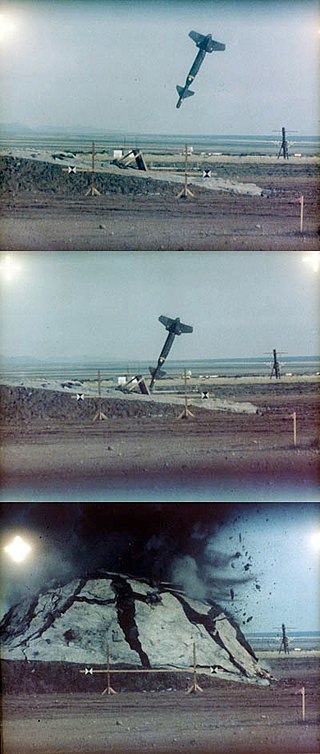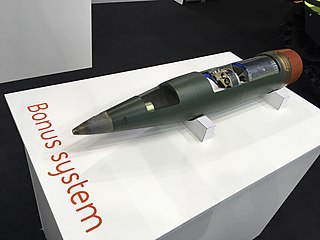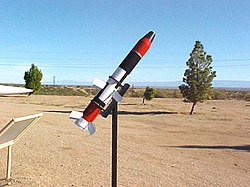
A missile is an airborne ranged weapon capable of self-propelled flight aided usually by a propellant, jet engine or rocket motor.

A mortar is usually a simple, lightweight, man-portable, muzzle-loaded weapon, consisting of a smooth-bore metal tube fixed to a base plate with a lightweight bipod mount and a sight. Mortars launch explosive shells in high-arching ballistic trajectories. Mortars are typically used as indirect fire weapons for close fire support with a variety of ammunition.

A shell, in a military context, is a projectile whose payload contains an explosive, incendiary, or other chemical filling. Originally it was called a bombshell, but "shell" has come to be unambiguous in a military context. A shell can hold a tracer.

Missile guidance refers to a variety of methods of guiding a missile or a guided bomb to its intended target. The missile's target accuracy is a critical factor for its effectiveness. Guidance systems improve missile accuracy by improving its Probability of Guidance (Pg).

A laser designator is a laser light source which is used to designate a target. Laser designators provide targeting for laser-guided bombs, missiles, or precision artillery munitions, such as the Paveway series of bombs, AGM-114 Hellfire, or the M712 Copperhead round, respectively.

A counter-battery radar or weapon tracking radar is a radar system that detects artillery projectiles fired by one or more guns, howitzers, mortars or rocket launchers and, from their trajectories, locates the position on the ground of the weapon that fired it. Such radars are a subclass of the wider class of target acquisition radars.

A guided bomb is a precision-guided munition designed to achieve a smaller circular error probable (CEP).

The M982 Excalibur is a 155 mm extended-range guided artillery shell developed in a collaborative effort between the U.S. Army Research Laboratory (ARL) and the United States Army Armament Research, Development and Engineering Center (ARDEC). The Excalibur was developed and/or manufactured by prime contractor Raytheon Missiles & Defense, BAE Systems AB and other subs and primes in multiple capacities such as Camber Corporation and Huntington Ingalls Industries. It is a GPS and inertial-guided munition capable of being used in close support situations within 75–150 meters (250–490 ft) of friendly troops or in situations where targets might be prohibitively close to civilians to attack with conventional unguided artillery fire. In 2015, the United States planned to procure 7,474 rounds with a FY 2015 total program cost of US$1.9341 billion at an average cost of US$258,777 per unit. By 2016, unit costs were reduced to US$68,000 per round. Versions that add laser-guidance capability and are designed to be fired from naval guns began testing in 2015. By October 2018, over 1,400 rounds had been fired in combat.
The XM1111 Mid-Range Munition (MRM) is a 120 mm precision guided munition developed for the Rheinmetall Rh-120 120mm gun used by several Western tanks. It was also intended to fulfill a requirement for Future Combat Systems (canceled) for a long-range, beyond line of sight (BLOS) tank munition.

The XM395 Precision Guided Mortar Munition (PGMM) is a 120 mm guided mortar round developed by Alliant Techsystems.

The Extended Range Guided Munition was a precision guided rocket-assisted 5-inch (127 mm) shell (projectile) development by Raytheon for the U.S. Navy. The program was cancelled in March 2008 after twelve years of development and over 600 million dollars in funding. The developmental round was designated EX 171.
The Ballistic Trajectory Extended Range Munition (BTERM) was a failed program to develop a precision guided rocket-assisted 127 mm (5-inch) artillery shell for the U.S. Navy. The program was originally named the Autonomous Naval Support Round (ANSR) and was developed by Alliant Techsystems.
The Long Range Land Attack Projectile (LRLAP) is a canceled precision guided 155 mm (6.1 in) naval artillery shell for the U.S. Navy's Advanced Gun System (AGS). LRLAP was developed and produced by Lockheed Martin Missiles and Fire Control, the prime contractor being BAE Systems.

The 2K25 Krasnopol is a Soviet 152/155 mm cannon-launched, fin-stabilized, base bleed-assisted, semi-automatic laser-guided artillery weapon system. It automatically 'homes' on a point illuminated by a laser designator, typically operated by a drone or ground-based artillery observer. Krasnopol projectiles are fired mainly from Soviet self-propelled howitzers such as the 2S3 Akatsiya and 2S19 Msta-S and are intended to engage small ground targets such as tanks, other direct fire weapons, strong-points, or other significant point targets visible to the observer. It can be used against both stationary and moving targets.

A precision-guided munition is a guided munition intended to hit a specific target, to minimize collateral damage and increase lethality against intended targets. During the First Gulf War guided munitions accounted for only 9% of weapons fired, but accounted for 75% of all successful hits. Despite guided weapons generally being used on more difficult targets, they were still 35 times more likely to destroy their targets per weapon dropped.
Cannon-launched guided projectiles (CLGP) are precision-guided munitions launched by howitzers, mortars, tank guns, and naval guns. Those projectile main propulsion system is the initial kinetic shoot, directed as much as possible toward the target. A secondary GPS or geocoordinates-based system then corrects the trajectory to increase target accuracy and fall closer to the target. This system relies on electronic guidance and pre-programmed coordinates, submitted to the round before its launch.

Sudarshan is an Indian laser-guided bomb kit, developed by Aeronautical Development Establishment (ADE), a DRDO lab with technological support from another DRDO lab Instruments Research and Development Establishment (IRDE), for the Indian Air Force (IAF).
The DF-ZF is a hypersonic glide vehicle (HGV) developed by the People's Republic of China. It is launched by the DF-17 medium-range ballistic missile. The combined weapon system was likely operational by October 2019.

The BONUS or ACED is a 155 mm artillery cluster round co-developed and manufactured by Bofors of Sweden and Nexter of France. It was designed to fulfill a long range, indirect fire, top attack requirement against armoured fighting vehicles.

The Pershing II Weapon System was a solid-fueled two-stage medium-range ballistic missile designed and built by Martin Marietta to replace the Pershing 1a Field Artillery Missile System as the United States Army's primary nuclear-capable theater-level weapon. The U.S. Army replaced the Pershing 1a with the Pershing II Weapon System in 1983, while the German Air Force retained Pershing 1a until all Pershings were eliminated in 1991. The U.S. Army Missile Command (MICOM) managed the development and improvements, while the Field Artillery Branch deployed the systems and developed tactical doctrine.



















